Is it ok to start or resume your postpartum weight training journey 6 weeks after having a baby?
Congratulations on bringing a new life into this world! As a new mother, you have already accomplished one of the most significant achievements of your life. Now that you have entered a new phase of your life, it is time to focus on your health and fitness goals. One of the most effective ways to achieve your fitness goals after childbirth is through postpartum weight training.
Not only does weight training help you lose weight and tone your muscles, but it also helps you build strength and improve your overall well-being. In this article, we will discuss the benefits of weight training postpartum, tips for getting started, and how to create a workout routine that fits your lifestyle. So, let’s get started on your journey toward a healthier and fitter you!
The first 2 steps are important for anyone who had a baby, regardless of whether you are about to start postpartum strength training for the first time in your life or you are an experienced gym goer or weight lifter.
Step 1. Your pelvic floor – do you know for sure it’s ok?
First and foremost, I would strongly suggest making an appointment with a women’s specialist physiotherapist so they can do an internal examination to check what condition your pelvic floor is in after giving birth.
A specialist women’s physio can assess the strength and function of the pelvic floor muscles and provide exercises and guidance to help improve any weakness or dysfunction. They can also provide education on proper lifting techniques and body mechanics to avoid putting additional stress on the pelvic floor muscles during exercise or daily activities.
If they believe that you need to strengthen your pelvic floor they may prescribe Kegel exercises, which means contraction of the pelvic floor muscles. They will teach you how to do it correctly and advise whether you should do it laying, seated or standing. It will depend on the condition of your pelvic floor.
The most important thing is to stick to the exercises consistently for a while as it’s the only way to improve you pelvic floor health and function as long as no surgery is required.

But I had a C-section, do I still need to check my pelvic floor?
Yes, it is still important for women who have had a C-section to get their pelvic floor checked by a specialist women’s physio after giving birth. Although a caesarean section delivery may decrease the likelihood of pelvic floor trauma compared to vaginal delivery, it can still result in pelvic floor dysfunction or weakness.
During pregnancy, the weight of the baby and the uterus can put pressure on the pelvic floor muscles, causing them to stretch and weaken. This weakening can lead to problems such as incontinence, pelvic organ prolapse, and sexual dysfunction. Additionally, the surgery involved in a caesarean section can also cause trauma to the pelvic floor muscles, which can further weaken them.
Overall, it’s important for all postpartum women, regardless of the mode of delivery, to prioritize pelvic floor health and seek the guidance of a specialist women’s physio if needed. A healthy pelvic floor is essential for overall health and wellness and can help support postpartum recovery and future physical activity goals.
But I’m not experiencing incontinence symptoms like leakage, does this mean my pelvic floor is fine?
No, just because there is no leakage, for now, it doesn’t automatically mean your pelvic floor is completely unchanged by childbirth or pregnancy, you can have minor prolapses on the internal walls of the vagina that you won’t know about until an internal examination is done by a specialist, and by commencing on weight lifting journey without knowing or rectifying this could cause major issues in the future. I am speaking as a mother, a weight lifter, a bodybuilding competitor and an experienced post-partum coach from my own personal experience.
Your uterus could have also been lowered during delivery or by the weigh of the baby in the last trimester. You need to know about this if that is the case.
My doctor did the 6 weeks check up and said I’m ok to start working out, can I just go ahead?
Unless you doctor has done a thorough internal examination you should see a specialist to make sure they do this. If there is an issue they will be able to guide you in the right direction as to what you should do and should avoid doing for the time being if there is any change in your pelvic floor.
Your body went through a huge change. You only need one appointment with your physio to determine whether you have pelvic floor issues or not before commencing training, you might need follow-up sessions with them though to rectify any issues. A good physio should conduct an internal examination and also use an ultrasound device where they will be able to determine how weak or strong your pelvic floor is by getting you to pull your pelvic floor upwards while they can see it on camera internally. Similar to an ultrasound that you did when you found out you were pregnant, but lower down your abdomen adjacent to your pelvic floor.
I strongly recommend for everyone go through a thorough pelvic floor check-up postpartum regardless of what style of exercise you plan on embarking on.
It’s been a few months since I had a baby and I have done some postpartum Pilates, doesn’t this mean my pelvic floor is great and strong now and ready to handle some weights?
No, Pilates instructors can guide you with good exercises that are suitable for pelvic floor strengthening, but they still can’t see the condition of your pelvic floor, you still should get it checked by a women’s specialist physio. It could be in a great state and then you will have that piece of mind, or it could be worse than what you think and needs urgent attention.
Mumma’s, I can’t stress this enough, as a coach of over 15 years, I have seen many of my new mum clients or even women who have had kids decades ago still unaware of how important this is and what issues later on it can cause. The attention is not given to this until they realize it’s too late, the damage is too bad to fix with exercises and they needed surgery.
Please don’t skim over this step this is why I put it first. Make the effort to check it out and make sure you get it sorted before going gung ho at the gym with weight or even just going about your life being a busy mum.
Step 2; Check if you have ab separation (diastasis recti).
This is also something you won’t know till you know what to look for or simply ask your physio check during your pelvic floor examination, it only takes about a minute for them to press their fingers on your tummy to check for a gap between the two sides of your abs and then they can give you advice on what you can and can’t do and what you should do to heal it if you have it.
The image below is obviously of a very lean person just to show you what happens to muscles underneath when abs are separated, most women won’t be this lean postpartum and fat layer on top of the muscles would conceal the separation and can go unnoticed until your physio does a physical examination. It’s easy and painless by just pressing fingers in the middle of the tummy while you crunch up and try to contract the muscles.

Diastasis recti or ab separation can often be one of the main causes why your tummy looks flabby or bulging out even if you don’t have a lot of body fat in other areas of your body. The muscles are open apart and loose.
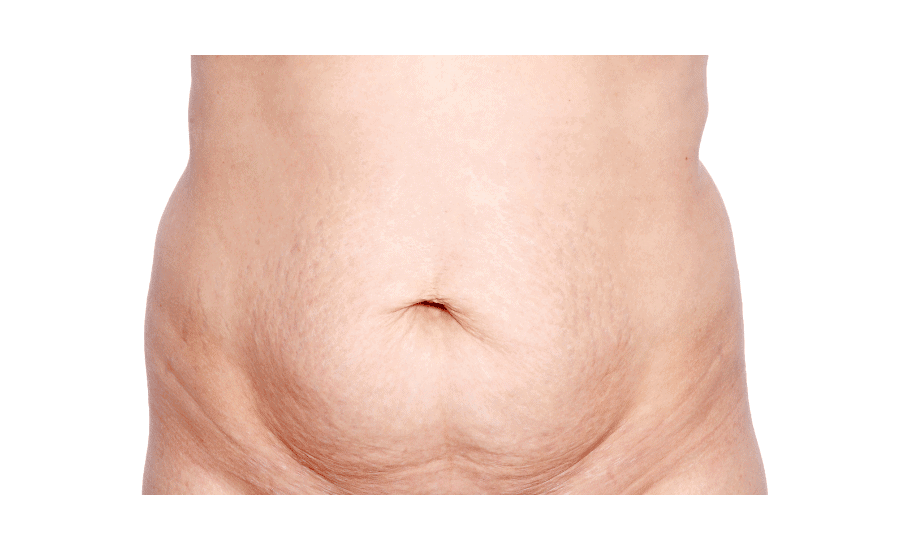
You may not always be able to completely close the gap, this doesn’t mean you can never regain your core strength or perform advanced core exercises, it just means you will have a slightly longer path to getting your core strong enough to do those things.
I have a permanent ab separation, it’s rare, but sometimes despite any attempts to repair and close the gap it just doesn’t.
Many women will find their gap close on it’s own, some will need some work to close and strengthen it, and a few like me will always have it, but still be able to get full control of their core muscles, so don’t despair if this happens. You can have an insanely strong core even with a small permanent gap, you will just need to learn how to control it and keep the abdominal walls together during exercises. It comes with practice, good core awareness and strength.
What problems can ab separation cause if ignored?
Abdominal separation can be the cause of severe back pain later on in life if you just let it be and don’t’ strengthen your core, it can also cause a hernia.
Just imagine the abdominal wall being the shield for your internal organs, if the shiels is compromised you can have all kinds of issues.
So don’t neglect it.
Should you start postpartum weight training 6 weeks after giving birth if you’ve never lifted weights before?
If you’ve addressed the first 2 steps I discussed then as long as there are no other medical issues you need to resolve then it is usually safe to commence body weight training or lifting light weights if you are a complete beginner.
Where to start?
If you’ve never exercised with weights before then a good place to start is with bodyweight exercises like learning how to do glute bridges, squats, lunges, step-ups, hold a plank and do assisted or elevated push-ups or bench dips first. You can add some resistance bands to add the burn and intensity.
I would place emphasis on glute strength with glute bridges and perhaps clam shells or fire hydrants. Glutes are important just like the core as a foundation for a successful strength training journey and can help reduce injuries in the future.
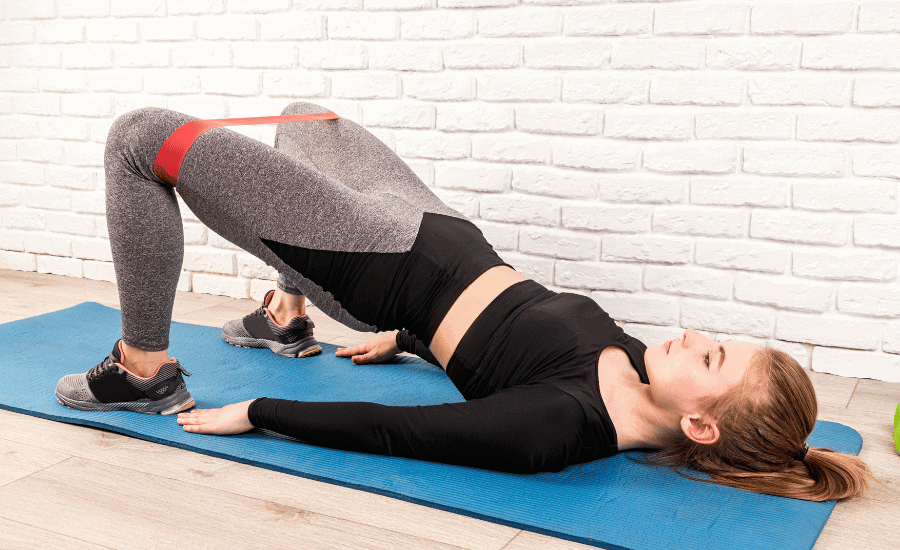
Once you get good at those and your balance is under control, especially on the lunges or step-ups, then you can add some dumbbells for the lower body exercises as well. From here you can gradually add more weight.
I often recommend starting at home as it may be less intimidating and you can have more flexibility without having to worry about babysitting for your baby, you can have them nearby on a play mat or napping while you do a 20-40 minute workout at any time.
Check out my list of home gym basic equipment like dumbbells, bands and a suspension trainer you can use at home. These are easy to get on a budget from Amazon to help you get started.
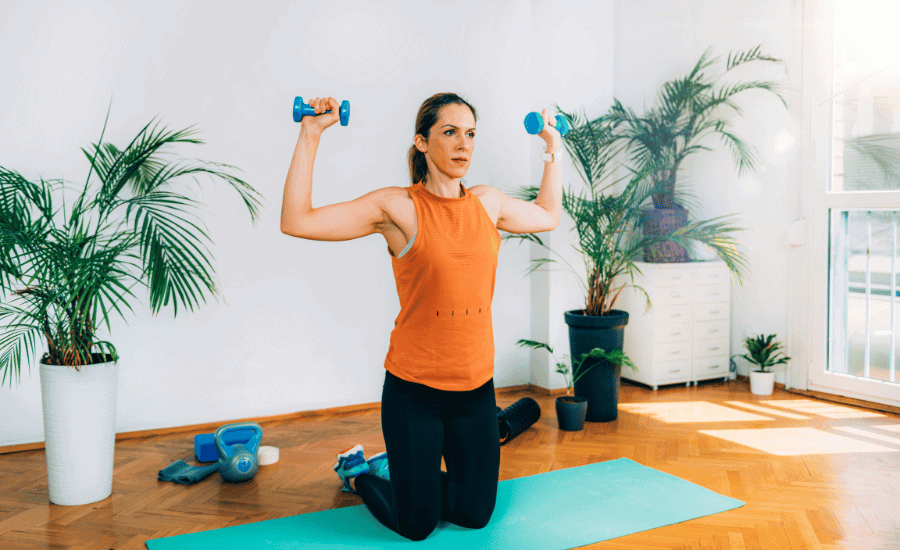
If you decided to join a gym, you can try some of the machines available, go during a less busy time if possible so you feel less awkward if you do things incorrectly the first time, but the best advice is to ask a staff member or a PT to show you how to use machines.
Always be mindful of you core and try to prioritise core exercises especially the 1st year after you’ve had a baby.
Most importantly be patient, everyones body is different and affected differently by pregnancy and childbirth, don’t watch what others are doing unless it’s for inspiration, just focus on working at your pace and don’t give up too soon.
It’s possible that you might not see significant changes or results until 6-12 months later. Most people give up just before they were about to start seeing changes, but because they gave up they never got there. So keep going, it always takes longer than you think, but it’s 110% worth it for you physical and mental health.
Make it a part of your new life, not just a quick fix which is why you shouldn’t rush the results. Exercise and weight lifting is not a punishment to fix your broken body, it’s a tool for a healthy happy lifestyle for many decades to come. You don’t have to exercise, you get to exercise because your body can. And that in itself is amazing my dear mumma.
Remember in time you will also be teaching your little one an amazing lesson that exercise is an importnat part of taking care of your health, they absorb what they see. When they watch you work out, it becomes the norm and will serve them in their lives in the futre. So you are not just doing it for you, you are doing it for them.
What about diet to help muscle building while shedding fat?
Let’s chat about food just quickly. This blog isn’t about the diet so I don’t want to dive into it too deeply, I will write an article on postpartum fat loss and muscle-building diet separately, but you probably already know that eating better will result in your actually seeing your body change. If your diet is full of processed quick-to-grab carby & bready fast snacks then the fat will stick around and you will struggle to see the muscles you are building underneath.
Getting good meals daily is super tough when you are a new mum, I get it, trust me, there just isn’t enough time in the day, you can try and opt for simple things like eggs, greek yogurt and protein shakes to get some quality protein in and you can also utilise a bit of help from ready-made fitness meals like Youfoodz, I have written a full Youfoodz review and my favourite high protein meals I recommend to try if you want to give it a go. You can read the review right here.
The more protein you eat, the faster your muscles will tone up and grow and the less junk food you will eat as you will feel more satiated. Eating well-balanced meals is key to muscle building and fat loss in the long term.
Getting back into postpartum weight training 6 weeks after baby, if you are not a beginner.
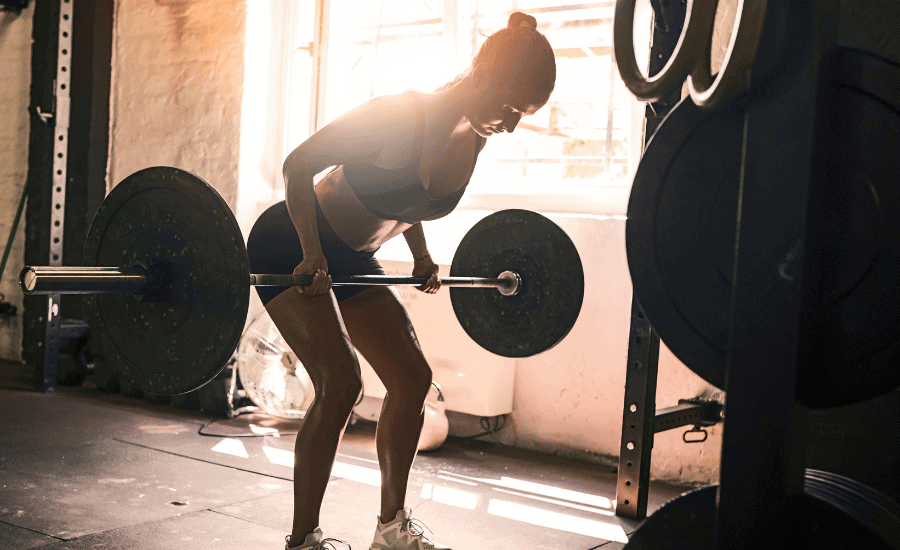
Now let’s talk to those of you who have been super fit and strong up until you got pregnant and super sick and fell off the wagon or simply want to get back into training as soon as possible after giving birth to your little one, so you can feel yourself again.
What you should avoid and what you should focus on for the next 6 months.
Let’s say you are not new to lifting weights and even have been hitting the gym for a while before the baby. Keep in mind your body just went through a lot regardless of whether you are a newbie or an experienced lifter.
But of course the journey will be very different for you, after you have gone through the pelvic floor and ab separation check up you can plunge into weights a little quicker. You already know your body and what it’s capable of.
As a rule of thumb, I would recommend starting back with about half the weight of what you used to do at home or gym, especially for your lower body. Give yourself about 3 months to work with light weights and hyper focus on core strength and deep core work to avoid any back pain in the future.
Core work should be your priority right now.
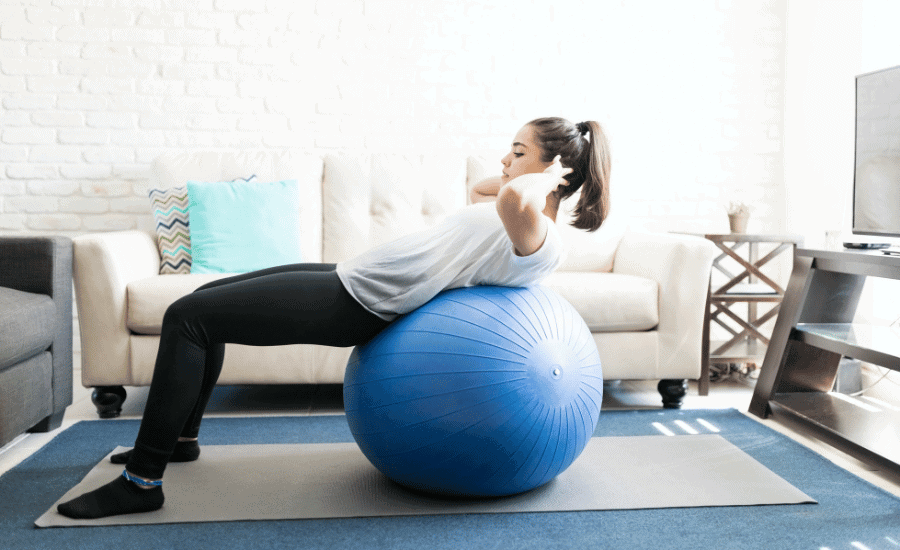
Upper body exercises especially the ones where you get to sit and your pelvic floor is supported you can go a little heavier and attempt weight that is close to what you were lifting throughout your pregnancy.
Exercises like barbell squats and lunges should be attempted with half the weight until you see how you feel and if your body recovers well without any pain or unusual type of discomfort.
If you miss the feel of that burn and challenge then add extra reps and harder bands to feel your muscles more and gradually add the weights as you progress and if you feel ok.
As a post-natal coach, I don’t recommend commencing training with your heaviest weight (before pregnancy weight) until you spend minimum 3-6 months of consistent core work. Regardless of how strong your core was before pregnancy it has been compromised and weakened by pregnancy and childbirth.
And even if your pelvic floor is in good condition given the circumstance you should still commence some pelvic floor strengthening work as soon as you are comfortable to do so, around 1-2 weeks post birth. Do this for a couple of months before throwing a heavy barbell on your back or deadlifting 50+kgs.
Think of working on regaining your strength from the inside out.
And yes, you most definitely can rebuild a strong body, even stronger than before baby. Childbirth does not mean you will never be able to do what you used to do before.
I have coached women and myself to be the strongest and fittest versions of themselves they’ve ever been, after multiple children and after 40. It’s possible and never let anyone tell you otherwise.
It just takes time, longer than you’d like, be prepared for that and be ok with it. If your expectations are too high you will end up getting frustrated and disappointed, treat this journey as a long-term goal to be the strongest badass you’ve ever been yet.
You can do this mumma!
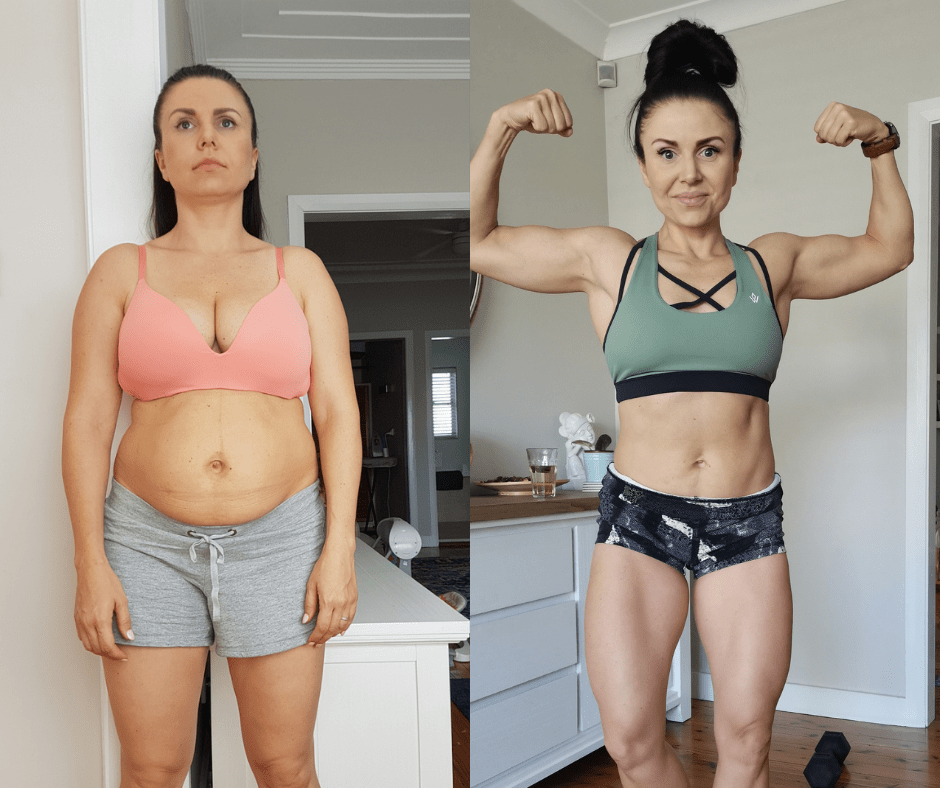
Other articles you might find useful.
Best Home Cardio Workouts With or Without Equipment.
Best Maternity Sports Bras Australia; where to buy under $80.
12 Best Air Fryers Australia 2023 – what type of air fryer is best for you & where to get the best deal.













